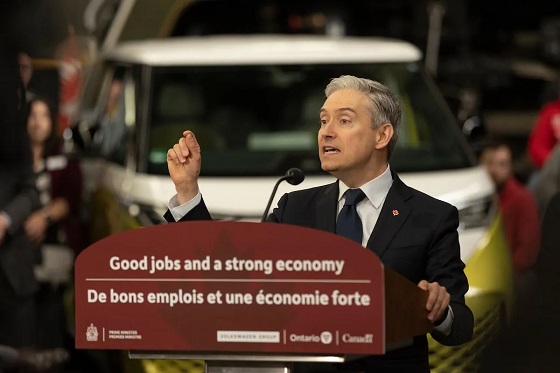Business
Todayville At The Home Show With Canadian Closet
Business
$15B and No Guarantees? Stellantis Deal explained by former Conservative Shadow Minister of Innovation, Science and Technology

Rick Perkins reveals what billions in subsidies didn’t buy: job protections, clawbacks, or Canadian hiring guarantees.
For weeks, Canadians were told, confidently, smugly, that the $15 billion handed to Stellantis and Volkswagen was protected by “job clauses” and “performance-based contracts.” That’s the line Industry Minister Mélanie Joly repeated in interviews, press releases, and on social media. It’s a lie.
Yesterday, we sat down with former Member of Parliament Rick Perkins one of the few people who actually read the unredacted contracts in question and he laid it out plainly: those job guarantees don’t exist. Not in the way you were told. Not even close.
“There is no cancellation clause,” Perkins said.
“The ‘job commitments’ are maximums, not minimums. And the contracts don’t require those jobs to be Canadian or even union.”
Let that sink in.
We were sold a vision of a green industrial renaissance, Canadian workers building Canadian batteries in Canadian factories, funded with Canadian taxpayer money. Instead, we’ve bankrolled foreign-owned companies to build batteries with no guarantee they’ll hire local workers, or that the batteries will even be sold in Canadian vehicles.
And here’s the kicker: the federal government is already writing monthly subsidy cheques, covering 100% of the cost per battery, based on production volume, not sales. That’s right. You and I are footing the bill whether those batteries go into a Dodge Ram, a Chinese-market minivan, or sit on a warehouse shelf until 2032.
No wonder the production subsidy contract is only 26 pages long. There wasn’t much in it.
Minister Joly claimed there are “performance conditions” and “job guarantees.” But as Perkins told us, those words are political wallpaper not legal obligations. There’s no enforcement mechanism. There’s no clawback clause. There’s no language saying, “You must hire X Canadians or repay the money.” It’s not there.
And that’s what this government doesn’t want you to understand. It’s not just that they wasted your money, it’s that they did it knowingly.
They gambled billions on the assumption that Joe Biden would remain in power, that EV mandates would keep growing, and that Trump wouldn’t come back. Now that he has, with tariffs, deregulation, and a clear “America First” energy agenda, these companies are doing what any rational business would do: they’re leaving.
And there’s nothing in the contract stopping them.
If you’re wondering why the mainstream media isn’t shouting this from the rooftops ask yourself who cashes the cheques. Ask yourself why no journalist has demanded to see the full, unredacted documents. Ask why Minister Champagne hasn’t been hauled before a committee and asked under oath whether he even read the damn contract before signing.
We did what they wouldn’t. We got the receipts. We sat down with someone who saw the deal with his own eyes. And here’s what he told us: it’s worse than you think.
The Stellantis deal isn’t a strategic investment, it’s a bailout with no brakes. And every month, billions continue to bleed out of the treasury while ministers issue press releases pretending we’re building an economy.
We’re not. We’re building someone else’s. And we’re paying full price.
This isn’t over.
Invite your friends and earn rewards
If you enjoy The Opposition with Dan Knight , share it with your friends and earn rewards when they subscribe.
Health
Canada surrenders control of future health crises to WHO with ‘pandemic agreement’: report

From LifeSiteNews
Canada’s top constitutional freedom group warned that government officials have “relinquished” control over “future health crises” by accepting the terms of the World Health Organization’s (WHO) revised International Health Regulations (IHR).
The warning came in a report released by the Justice Centre for Constitutional Freedoms (JCCF). The group said that Prime Minister Mark Carney’s acceptance earlier this year of the WHO’s globalist-minded “pandemic agreement” has “placed Canadian sovereignty on loan to an unelected international body.”
“By accepting the WHO’s revised IHR, the report explains, Canada has relinquished its own control over future health crises and instead has agreed to let the WHO determine when a ‘pandemic emergency’ exists and what Canada must do to respond to it, after which Canada must report back to the WHO,” the JCCF noted.
The report, titled Canada’s Surrender of Sovereignty: New WHO health regulations undermine Canadian democracy and Charter freedoms, was authored by Nigel Hannaford, a veteran journalist and researcher.
The WHO’s IHR amendments, which took effect on September 19, are “binding,” according to the organization.
As reported by LifeSiteNews, Canada’s government under Carney signed onto them in May.
Hannaford warned in his report that “(t)he WHO has no legal authority to impose orders on any country, nor does the WHO possess an army, police, or courts to enforce its orders or regulations.”
“Nevertheless, the WHO regards its own regulations as ‘an instrument of international law that is legally binding on 196 countries, including Canada” he wrote.
Hannaford noted that “Surrendering Canada’s sovereignty” to the IHR bodies is itself “contrary to the constitutional principle of democratic accountability, also found in the Canadian Charter of Rights and Freedoms.”
“Canada’s health policies must reflect the needs, desires, and freedoms of Canadians – not the mandates of distant bureaucrats in Geneva or global elites in Davos. A free and democratic Canada requires vigilance and action on the part of Canadians. The time to act is now” he wrote.
Among the most criticized parts of the agreement is the affirmation that “the World Health Organization is the directing and coordinating authority on international health work, including on pandemic prevention, preparedness and response.”
While the agreement claims to uphold “the principle of the sovereignty of States in addressing public health matters,” it also calls for a globally unified response in the event of a pandemic, stating plainly that “(t)he Parties shall promote a One Health approach for pandemic prevention, preparedness and response.”
Constitutional lawyer Allison Pejovic noted that “(b)y treating WHO edicts as binding, the federal government has effectively placed Canadian sovereignty on loan to an unelected international body.”
“Such directives, if enforced, would likely violate Canadians’ Charter rights and freedoms,” she added.
Hannaford said that “Canada’s health policies must be made in Canada.”
“No free and democratic nation should outsource its emergency powers to unelected bureaucrats in Geneva,” he wrote.
The report warned that new IHR regulations could mandate that signatory nations impose strict health-related policies, such as vaccine mandates or lockdowns, with no “public accountability.”
“Once the WHO declares a ‘Pandemic Emergency,’ member states are obligated to implement such emergency measures ‘without delay’ for a minimum of three months,” the JCCF said.
“Canada should instead withdraw from the revised IHR, following the example of countries like Germany, Austria, Italy, the Czech Republic, and the United States,” the JCCF continued. “The report recommends continued international cooperation without surrendering control over domestic health policies.”
Earlier this year, Conservative MP Leslyn Lewis condemned the Liberal government for accepting the WHO’s IHR.
-

 MAiD1 day ago
MAiD1 day agoDisabled Canadians increasingly under pressure to opt for euthanasia during routine doctor visits
-

 Alberta2 days ago
Alberta2 days agoPetition threatens independent school funding in Alberta
-

 National2 days ago
National2 days agoPolitically Connected Canadian Weed Sellers Push Back in B.C. Court, Seek Distance from Convicted Heroin Trafficker
-

 Business2 days ago
Business2 days agoCanada Revenue Agency found a way to hit “Worse Than Rock Bottom”
-

 Automotive2 days ago
Automotive2 days agoParliament Forces Liberals to Release Stellantis Contracts After $15-Billion Gamble Blows Up In Taxpayer Faces
-

 Censorship Industrial Complex2 days ago
Censorship Industrial Complex2 days agoWho tries to silence free speech? Apparently who ever is in power.
-

 Business2 days ago
Business2 days agoCanada has fewer doctors, hospital beds, MRI machines—and longer wait times—than most other countries with universal health care
-

 Brownstone Institute1 day ago
Brownstone Institute1 day agoThe Doctor Will Kill You Now







